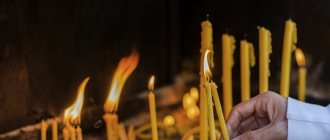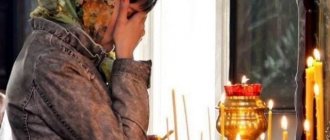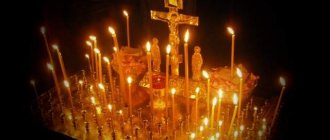"Save me, God!".
Thank you for visiting our website, before you start studying the information, please subscribe to our Orthodox community on Instagram, Lord, Save and Preserve † - https://www.instagram.com/spasi.gospodi/. The community has more than 60,000 subscribers. There are many of us like-minded people and we are growing quickly, we post prayers, sayings of saints, prayer requests, and timely post useful information about holidays and Orthodox events... Subscribe. Guardian Angel to you!
Each of us throughout our lives is faced with the bitter loss of a loved one. During this period, many people experience a feeling of fear and anxiety. This is not surprising, because in the rite of farewell to the deceased there are not only sad emotions, there is also a lot of mystery and mysticalness in it. Elderly people claim that one wrong movement during the burial of a person’s body can doom his soul to eternal suffering. In addition, some mistakes during the ritual can bring disaster to the living. How true this is is not known. But in any case, you need to know what actions need to be carried out at a funeral and how many days after death a person is buried.
How many days after death are funerals organized?
In Orthodoxy, special significance is attached to the number “3”. The Holy Trinity consists of the Father, Son and Holy Spirit, the theological virtues include faith, hope and love. The sacred meaning of the number is confirmed by the presence in the Gospel of 3 wise men, the same number crucified on Golgotha, and the resurrection of Jesus Christ on the third day after death.
Orthodoxy believes that the soul breaks ties with the body gradually. The ancient Slavs were also sure of this, who cremated the deceased after the priest read parting words from the “Book of the Dead” to the deceased for 3 days in a row. Our ancestors believed that the intangible component of a person remains on Earth until 40 days after death. Special rituals—ablution, crod, funeral feast, lists—helped make the separation of the soul and body as painless as possible.
Christian customs pursue the same goal. According to the Orthodox tradition, the soul leaves the body on the 3rd day, Tretina, and, together with its guardian angel, goes to the Kingdom of Heaven. There, from days 3 to 6, she observes the indescribable beauty of the heavenly abode. According to customs, they are buried on the 3rd day; it must be counted from the moment of the person’s death, even if the tragic event occurred closer to midnight. Thus, a person who died on November 12 at 23.00 is supposed to be given land on the 14th, not the 15th. The third day is also associated with the image of the Holy Trinity, a holiday that is associated with memorial rites. It was the moment of the resurrection of Christ that showed the world confirmation of the integrity of the trinity - the Holy Spirit emanating from God was revived by the Son of God.
Funeral in Orthodoxy
Orthodox funeral and memorial traditions teach us to look at the lifeless body of a believer with tremendous respect. Even in the hands of death, he remains a member of the Church of Jesus, and his body is considered a temple where the Holy Spirit previously resided. Over time, this body, according to the laws of the Church, will come to life and acquire the qualities of incorruptibility and immortality.
Orthodoxy about death:
Tests of the soul after death How to survive the death of a loved one What is a funeral service and how to properly remember the deceased
Orthodox funeral
Each nation showed special attention to the bodies of its deceased fellow citizens. Funeral rites expressed individual spirit and care for the deceased. The Jews performed short rituals, avoiding embalming and cremation; they anointed the bodies with incense, wrapped them in thin linens and placed them in caves.
In memory of the deceased, they broke bread, sprinkled ashes on their own heads, and often observed a mourning fast.
Preparation for burial
The traditions of funerals and wakes have the deepest meaning and are based on the ancient rules of the first Christians.
The body of a follower of the Christian faith is washed immediately after physical death. This ritual is performed as a sign of the absolute purity and purity of the spirit, which will appear in a similar form before the eyes of the Lord. All parts of the body are washed: they use warm water, ordinary soap and a soft rag (sponge). Simultaneously with the ritual, the Trisagion hymn is read, and a lamp is lit, which should burn as long as the body of the deceased is present in the room. Elderly people or clean women who have taken a bath themselves are allowed to participate in the ritual of ablution. After this ritual, the body of the deceased is dressed in new and washed clothes, which symbolizes the incorruptibility and immortality of the soul. Soon after death, a Christian will appear at the Judgment and give an account to the Almighty Creator for his past life. An Orthodox cross is put on the person, and his limbs are tied. Hands are carefully folded on the chest so that the right one is on top. A small icon is placed in the left right hand (for men it is the image of Christ, for women it is the image of the Virgin Mary). This shows that the deceased believed in the Son of God, betrayed his own soul to Him, and now moves on to the eternal, most pure and reverent contemplation of the Holy Trinity. On a note! To reinforce the authority of the ablution ritual, they use the testimony of writers who lived after the apostles. Detailed instructions for performing the ritual are described here. In the past, Christians took sacred care of the body of the deceased, washing it and singing the psalms of King David.
Orthodox funeral
Burial and its sequence
At the death of an Orthodox believer, a canon of eight songs compiled according to church rules is read. It is used because a person experiences a natural feeling of fear before death. The clergy confirm: the soul succumbs to this affect when separated from the physical shell, to which it is very accustomed. It is especially difficult for a person’s consciousness in the first 3 days after death: here people see Guardian Angels who accompanied them all the time after the ritual of Baptism, as well as evil spirits , causing horror with their disgusting appearance. The canon should be read so that the soul of the deceased finds peace in the afterlife. Relatives are obliged to find courage and say goodbye to the deceased relative, fulfilling a prayer request before the Heavenly Father. Before burial, the body of a Christian and his coffin are symbolically sprinkled with holy water. A whisk is placed on the forehead of the deceased, which is given by the priest for the funeral service. This symbolizes that the Orthodox believer left the field of action with honor, having won the struggle against painful life and frightening death. On the aureole are the faces of the Son of God, the Mother of God and St. John the Baptist, as well as the inscription “Trisagion.” A cotton pillow is placed under the head and shoulders of the deceased Christian, and the body is covered with a white sheet. More often, the coffin is placed in the middle of the room in front of the home iconostasis; the face of the deceased should look at the images of the saints. Candles are lit around the deathbed, heralding the deceased believer's passage into the realms of light and tranquility. Interesting! Monks and priests are traditionally not washed after their death. The first ones are dressed in a specific robe and wrapped in a mantle in a cruciform manner. The monks' face is covered, indicating its distance from worldly passions during earthly existence. Priests are dressed in church clothes, and a covering is placed on their heads, indicating the involvement of the confessor in the Mysteries of the Lord.
Prayers after ablution
When the body of a deceased Christian has been cleansed of worldly defilement, they begin to read the canon, which is called “The Sequence of the Exodus of the Soul from the Body.” In the chorus, people ask the Lord for the repose of the deceased, and at the end they ask for eternal help. This canon helps to alleviate the mental suffering of a deceased person, who immediately after death experiences irresistible bitterness from parting with the body and the outside world.
About funeral prayer:
Prayer of the Mother of God for the newly departedPrayers for the repose of the soul of every deceased ChristianSorokoust for the repose
Singing song 5, the clergy and relatives ask the Almighty to generously pardon the deceased. In song 4 there is an appeal to the Holy Trinity, which is capable of illuminating with true light a soul darkened by the vanity of worldly life.
The initial troparion is a praise to the Mother of God, who gave birth to the Savior without a seed. The living ask for the salvation of a deceased person.
Next, for three days, the words of the Psalter are raised over the body of the deceased, which is divided into 20 parts (kathisma) and begins with a petition from the Lord for mercy. Each kathisma contains a threefold exclamation of “Glory,” which demonstrates the power and mercy of the Heavenly Father. Then prayers are chanted.
Psalter
The Psalter is read without interruption until the coffin is buried. Pious friends are allowed to sing, since family members have a lot of chores to do in organizing the funeral. The Psalter is of enormous importance in the ritual of farewell to the body.
He vividly reproduces emotional emotions, sympathizes with joy and sadness, and sheds a bright light of consolation into the grieving hearts of loved ones. The Church allows the text of the Psalter to be pronounced at its own discretion: the idea arises that the deceased independently turns to the Almighty for the sake of pardon.
Rituals in the temple
One hour before the removal of the body from the house, the canon about the exodus of the soul is read. According to tradition, the deceased is carried out feet first. During the removal, a prayer is sung in honor of the Holy Trinity. This suggests that the deceased sincerely confessed to the Lord and from now on moves into the Kingdom of Heaven, where he will dwell as a disembodied spirit, surrounding the Throne and singing praise.
When the body is brought to the temple, it is placed in the middle, facing the sacred altar, and lamps are lit on 4 sides. The Church teaches: on the 3rd day of death, the thin shell (soul) of the deceased Christian experiences terrible suffering, although the body remains dead and lifeless. During this difficult period, the deceased is in extreme need of help from the clergy, so specific canons and the Psalter are read over his coffin, and the funeral ceremony is also performed, which consists of liturgical chants that briefly illustrate the fate of a person. Sinfulness does not kill the glory of the Lord in the soul of people, therefore the Church asks for mercy and the right of every righteous person to enter the Heavenly City. In order to support humanity and rid the hearts of people from the sadness and dangerous doubts that are sometimes born at the sight of death, the Apostle Paul majestically consoles us, transferring religious thought beyond the limits of corruption and revealing the divine secrets of the wondrous transfiguration ashes into the eternal spirit. In addition, Jesus the Savior himself, dressed in the robes of a priest, allegorically encourages the relatives of the deceased when the Gospel of John is read in the temple. After this, a prayer of permission is proclaimed, destroying the worldly sinfulness of the deceased Christian. The farewell ritual consists of kissing and singing touching stichera over the coffin, which says that the deceased leaves frailty and vanity, finding peace by the mercy of the Almighty Lord. Relatives humbly walk around the coffin, bow and ask to forgive them for the absurd insults inflicted. The last kiss is directed at the aureole or small icon located on the chest.
Orthodox funeral service
Finally, the deceased is covered with a sheet, and the priest sprinkles the body with earth in a cross-shaped motion, pronouncing sacred words. The coffin is sealed and never opened again. When the deceased is taken out of the temple, the relatives sing the Trisagion. Note! If the church is located at a great distance from the home of the deceased Christian, an absentee funeral service is performed, which is ordered by relatives in the nearest monastery.
After the ritual, a prayer book of permission is placed in the right hand of the deceased, and a paper whisk is traditionally placed on the forehead; During farewell, the body, wrapped in sheets, is sprinkled with earth in a cross pattern.
The actual burial ritual
In the grave itself, the deceased person is turned to face the East, which symbolizes the expectation of the church morning (second coming) of the Son of God. When the coffin is slowly lowered into the prepared space, the Trisagion prayer is sung again. Before burying, everyone present throws a lump of earth into the hole. This speaks of submission to a higher providence.
The cross, which is a symbol of salvation, is placed at the feet of the deceased. From now on, a Christian who believes in the crucified Savior rests in the long sleep of death under the care of the Father. The cross must be of the correct shape and eight-pointed.
Oil of oil is not traditionally poured on a dead body or placed in a coffin, but is only used during life for healing.
Orthodox tradition blesses people who help carry out the rituals of washing, putting on clean clothes and burials. It is believed that these actions are the last and necessary mercy that we are able to provide for a Christian who has passed into another world.
On what day is it better to bury the deceased: historical background
They give it to the earth at a certain time and for completely everyday reasons. After stories about the burial of living people, the concept of taphophobia appeared - a panicky fear of ending up in a grave in a cemetery after a person was mistakenly considered dead.
History knows of cases where relatives, due to ignorance, buried loved ones who were in a state of deep fainting or lethargic sleep. Legend has it that the writer N.V. was buried alive. Gogol. The Italian poet Francesco Petrarca fell into a lethargic sleep for 20 hours, and only a miracle allowed his loved ones not to bury him on the day of his death, as was customary to do according to Italian laws of the 14th century. Due to the presence of taphophobia, the German philosopher Arthur Schopenhauer drew up a will in which he asked to count 5 days from the moment of his death and only then give it to the land. In Europe, delaying funerals for three days from the moment of death of a person was introduced by decree of Duke F. of Mecklenburg only at the end of the 18th century.
How the wake goes on the third day. Funeral service and farewell dinner
The first funeral dinner is held immediately after the burial procedure is completed, when the body is lowered several meters underground. Everyone who was present during this ceremony is invited. First you need to read the main prayer - “Our Father”. They start the meal with kutya. You need to eat 3 spoons, less is not allowed. Next in line are the main courses. Tables should not be luxurious and alcohol should not be served. You can distribute the remaining food, separately prepared sweets, pies to the poor and homeless.
REMARKS ARE HELD ON THE 9TH AND 40TH DAYS, AND ALSO 1, 2, 3 YEARS FROM THE DAY OF DEATH AND ON EVERY SUBSEQUENT ANNIVERSARY.
Is it possible to bury on church holidays?
The ability of the soul to freely enter the Kingdom of Heaven depends on when the funeral is held. Therefore, Orthodoxy does not allow this ceremony to be performed on the following major holidays, especially if they coincide with a Sunday:
- Nativity;
- Easter Sunday;
- Trinity;
- Protection of the Blessed Virgin Mary.
Funeral services that fall on Easter are supposed to be moved to Radunitsa. The Bible does not prohibit burying on Sunday. On the 3rd day after death, which falls on Monday, it is customary to bury suicides, and on Thursday - those who died from natural causes. Relatives of the deceased must remember that, regardless of the day of the week, they cannot perform funeral services and ask for commemoration in church, or bury people who have committed suicide in the cemetery. An exception is made for some groups:
- people with established mental illness;
- upon suspicion of violent death, which the criminals hoped to pass off as suicide;
- when the reasons for a person’s death are not fully understood.
On Good Friday, which falls on the 3rd day, no funeral ceremony is held. If there are any doubts about what day Orthodox Christians are buried, how to calculate and whether the date is set correctly regarding Christian holidays, relatives should consult with a clergyman. It must be remembered that within 3 days, if the rules of the ritual of repose are observed, the first phase of the separation of soul and body is completed.
Duration of burial in Islamic tradition
The rules for burying dead Muslims are described in Sharia, as well as in the Koran itself. These requirements were formed mostly on the territory of the Arabian Peninsula, where heat and heat have reigned for many centuries. Under such conditions, postmortem decomposition processes occur especially quickly.
Therefore, in Islam it is customary to bury the deceased as soon as possible, if the time of death allows, on the same day, and before sunset. Believers are prohibited from visiting the cemetery at night.
Church requirements
It is necessary to order a memorial service, a special funeral service, for Tretina. Commemorations on this day are in honor of the resurrection of Jesus Christ and in honor of the image of the Holy Trinity. A memorial service is served both in the church and in the cemetery during or after the funeral, at home with the relatives of the deceased. The prayers of not only the priest, but also those of loving people can facilitate the passage of the ordeal of the soul of the deceased. And such commemoration brings tangible benefits to the relatives and friends of the deceased themselves - it brings comfort and dulls the pain from the loss of a loved one.
In the recent past, after death, Christians read the Psalter for the deceased for 40 days and took prosphora for the deceased in church every day during the liturgy. Today, relatives of the deceased go to church on Tretina and attend the service with candles, a symbol of faith in a pure and bright future life. At the end of the prayer, the candle fire is extinguished as a sign that everyone’s earthly life will sooner or later also cease to exist.
Funeral arrangements from the Honest Agent service
If you want the burial to take place in strict accordance with religious canons, please contact. We have been organizing funerals for many years, so we are perfectly familiar with all Orthodox traditions. Our employees know well how funerals are conducted, on what day a person must be buried and what rules must be followed when conducting a funeral ceremony.
When preparing for burial, our bureau provides comprehensive customer service. If you turn to the help of “Honest Agent”, you can count on the following services:
- preparation of the necessary documentation;
- preparation of the coffin and ritual accessories, taking into account the relatives’ budget;
- transportation of the deceased to the morgue and cemetery;
- digging a grave;
- farewell hall rental;
- installation of monuments and gravestones.
We understand well all the pain of your soul, therefore we work efficiently, carefully and with special attention to every detail. Contact us to bury your relative with dignity, taking into account Christian traditions. To receive advice or order funeral services, call us or request a call back!
Tell your friends:
Cases when a person is not buried 3 days after death
In summer, in regions where there is extreme heat and in exceptional circumstances (during wars, epidemics), clergy allow the farewell ceremony to be held earlier. Orthodoxy allows burial on days 4-6, depending on how the person died. To establish the causes of death, an autopsy procedure is performed, which lasts a certain time, especially if this occurs due to suspicion of violent death. Sometimes the relatives of the deceased have to wait for relatives and loved ones to arrive from afar, so funeral procedures are postponed, and the body of the deceased is embalmed. The procedure is carried out to preserve the aesthetic appearance of the deceased and to stop the processes of decomposition of the remains. Embalming and postmortem preparation are done in the morgue.
It is categorically not welcomed by Christianity to bury the deceased on the first or second day after death for no apparent reason. This is due to the belief that the spiritual substance of a person has not yet said goodbye to the body - its temporary bodily refuge. Forcibly breaking the connection before the onset of Tretina will lead to the fact that the soul will have nowhere to go. On the second day she should be with her family. In addition, contemplation of how its material container is consigned to the earth ahead of time in a coffin can cause inexpressible pain to the soul.
How is commemoration carried out after three days from the date of death?
When the funeral begins, then, provided that the deceased was an Orthodox person, a funeral service must be held.
A Christian funeral service is performed only once. To conduct a funeral service, you must initially agree, for example, with a priest. At the same time, they will tell you what preparations are needed and announce the amount.
After the funeral service, a wake is organized. This tradition started a long time ago. Previously, alms were distributed to the needy in memory of the deceased. Funeral services can be held two, nine and forty days after death, as well as on the day of the angel of the deceased.
During the week, during Lent, funerals are not held. They are rescheduled for the weekend.
Memorial days that fall on Bright Week or on the second Monday after Easter are moved to the 9th day after Easter, that is, to Radonitsa. This is a special day for remembrance. On Radonitsa it is allowed and customary to visit cemeteries, say prayers and clean the grave.
You cannot have a feast at the grave.
The classics of the funeral table are kutia and funeral pancakes. Start with these dishes. But this is not a prerequisite; if it is not possible to cook them, then you should not bother.
Next on the menu is traditional kutia. It consists of wheat grains that need to be washed and soaked for several hours and then boiled until ready. Then the grains are mixed with poppy seeds or honey. Cooking kutia from rice is similar. You can also drink alcoholic beverages at the feast.
We need to find the line between noisy celebrations and wakes.
For believers who are fasting, you need to prepare appropriate food, that is, without meat. The rest of the food is prepared according to people's wishes.
Why are they buried 3 days after death: psychological reasons
Close people, even those who have been caring for terminally ill relatives for a long time, are never internally fully prepared for their death. There is nothing to say about the power of tragedy and grief when children die. Despite the concepts of eternal life and the liberation of the soul from earthly suffering, loss becomes a heavy blow that can only be realized after time. At first after death, it is difficult to accept the fact of a person’s passing, much less to make preparations for burial and farewell. Excessive grief and lamentation complicate the process of parting with the earth for the soul, because on the first day, according to Orthodox beliefs, it already experiences confusion. After some time, relatives and friends have an internal readiness to let go of the deceased - to decide on what day to hold the wake and how to conduct the funeral.
Due to these psychological nuances, carrying out the burial procedure some time after the death is completely justified. Therefore, on Tretina they bid farewell to the deceased and organize a memorial dinner.
Rules for Orthodox funerals
The rules of Orthodox funerals are compliance with the canonical stages of the Orthodox rite. It is imperative to use ritual items for Orthodox funerals, prescribed by the canon.
- ablution
- vestments
- entombment
- cross, shroud, icon
- funeral prayers for the deceased - memorial services
- funeral lithium
- funeral service
- burial
- commemoration (remembrance)
Stages of the Orthodox funeral rite
Ablution is a rite of purification. The body of the deceased appears before the Lord pure and immaculate.
The deceased is dressed in clean clothes, a cross is put on him, covered with a white shroud, sprinkled with holy water, and placed in a coffin, which is placed with the head facing the icons.
Entombment
Close the deceased’s eyes, close his lips, and place his hands with the enclosed icon or cross in a cross shape.
Before the body is removed, funeral prayers are performed for the deceased - memorial services. You need to start after placing the clothed body on the table, then in the church. Before removing the body, a funeral litany is read.
Funeral service in the temple
The funeral service ends with a funeral litia.
When lowered into the ground, the clergyman reads the litiya, then sprinkles earth on the shroud of the deceased, after which a lid is placed on the coffin. If the clergyman is not at the funeral, the ceremony of interment is performed in the church, and the mourners are given earth, which they sprinkle on the body before closing the coffin.
After closing the coffin and lowering it into the ground, the priest pours oil on the coffin, sprinkles it with ashes and grains of wheat, then with earth. Those saying goodbye throw a handful of earth into the grave. Committing the body to the earth symbolizes the hope of resurrection - the body will sprout like a grain thrown into the ground.
A cross is placed at the head of the grave as a confession of faith in the Lord, who on the cross conquered death and called all living to follow his path. 3rd day after death.
This is a ritual of remembering a person and his good deeds, as well as praying for the repose of his soul. Funeral services are held three times: on the day of burial, on the 3rd day after death, on the 9th (nine) and on the 40th (fortie).
Funeral service on the day of burial
It is held immediately after the burial in remembrance of the Resurrection of Christ on the third day after his execution. For the first two days after death, the soul of the deceased remains on earth and carries on a conversation with himself, family and friends.
Everyone who accompanied the deceased to the cemetery is invited to the memorial meal, as well as those who were unable to attend. Before the start of the funeral, a relative of the deceased stands in front of the images with a burning lamp and reads the 17th kathisma of the Psalter, after which everyone reads the prayer “Our Father”. When starting the meal, everyone makes the sign of the cross. During the remembrance they talk about the deceased.
Funeral table menu
The first dish is kutia - a mixture of whole grains of rice (or wheat), raisins and honey. Grains are a symbol of the Resurrection (the body of the deceased will sprout like a grain). Kutya is consecrated in the church at a memorial service. Each participant in the ritual eats this dish. In addition to kutya, they eat pancakes and drink jelly and sati (water with honey). In Lent the memorial meal is lenten, in the meat-eating meal it is lenten.
These commemorations are sent to the glory of the angels, who ask the Lord to have mercy on the deceased. On the ninth day after repose, the soul of the deceased appears before the Lord for worship, therefore the ritual and prayers of the 9th day help the soul pass this test with dignity. On nine days a memorial service is served, and the relatives of the deceased are invited to the meal. After the second commemoration, from the 9th to the 40th day, the soul of the deceased goes to hell and realizes the sins he has committed.
Held in honor of the Ascension of the Lord on the 40th day after the Resurrection. On this day, the fate of the deceased is decided, whom the Lord judges according to earthly affairs and the achievements of the soul, after which he assigns him a place according to his deserts in anticipation of the Last Judgment. The deceased is remembered on this day so that his soul appears before the Lord and receives the promised bliss in heaven. The purpose of the fortieth day is to try to atone for the sins of the deceased.
The purpose of the fortieth day is to try to atone for the sins of the deceased. After the forties, the deceased is commemorated on birthdays, deaths and name days.
The attitude of the Orthodox Church towards cremation
The Orthodox Church has a negative attitude towards cremation, since after the resurrection the body must rise before the incorruptible Lord, and burying the body in the ground expresses for Christians the hope of resurrection. That is why the Christian Church has adopted and preserves the custom of not destroying the body (burning), but burying it in the ground - like a grain is sown in the ground so that it comes to life and sprouts. The church allows cremation only in cases where there is no other option. A blessing for cremation must be obtained from a priest, describing the circumstances of the case. It is not permitted to bring an urn with ashes to church after cremation for the funeral service. If a person is cremated, it is possible to order only a shortened funeral service for him - an absentee funeral service.
Due to various socio-economic circumstances in Russia, more and more believers prefer cremation to burial.
Why it is not recommended to attend funeral ceremonies on a birthday
Birthday people often wonder if they should attend a funeral that coincides with their holiday? There are no restrictions on the part of the church on visiting a cemetery or interring a person’s body on his birthday. However, in the latter case, annual visits to the grave of the deceased by relatives for 3 years are mandatory.
According to an alternative point of view, human energy is especially vulnerable on the day of birth, as well as a week before and after the event. On a subconscious level, the birthday person re-experiences a traumatic episode of life - birth. Funerals and other mourning ceremonies that fall on this date should be attended if you need to see off a close relative on their last journey. However, you can reschedule the celebration to another time and remember the deceased without visiting the cemetery.
It is not difficult to calculate and find out the correct date of the funeral. This point is fundamental for a Christian believer. The daily count starts from the day of death. The first time, which lasts until the forties, is very important for the soul of the deceased to pass through all stages of dissociation from the body. Knowing on what day they are buried after death and the observance of traditions by the relatives of the deceased makes the hardships of the transition period easier for the soul. One of the rituals associated with the farewell of the deceased to the mortal world is the burial of the body, which is traditionally carried out on the 3rd day after death.
Burial rite
The rite of burial of the deceased is a rite of farewell to the deceased, which has been customary to carry out in the Orthodox world since ancient times. It exists so that on this day one can express one’s respect and respect to people who have suffered death.
On this day, all the relatives, friends and acquaintances of the deceased gather to say goodbye to him forever and see him off on his last journey. The ritual also carries a powerful information message. Its holding reminds those present that their existence on earth is not eternal, which in turn should make many think about their lives.
The best article for you, go to: Home iconostasis: how to arrange icons, how to make it yourself
The Orthodox Church views funerals as a transition from earthly life to eternal life. To get to heaven a person must undergo special training. It consists of the following stages:
- Unction. If the death is not sudden, but the person was very ill, then before death the priest performs unction.
- Confession. Before death, a person must confess and ask for remission of all his sins.
- Conducting the communion ceremony. The priest must conduct the rite of communion to the dying person.
- Reading special canons. Since ancient times, prayers have been read to a dying person before death. This can be done by both the priest and relatives.
- Washing and changing clothes. After a person has died, he must be washed with clean water and wiped dry. This is done so that he appears clean before God. The deceased is also dressed in light and clean clothes. After this is done, it is necessary to cover the deceased with a shroud.
- Funeral lithium. It is read an hour before the coffin is taken out of the house. The priest sprinkles the coffin with holy water and conducts the funeral liturgy.
- Funeral service. Before the burial takes place, the priest reads a series of prayers and chants.
Only after all the stages described above have been completed is it believed that the deceased will be able to find eternal life in the next world.








